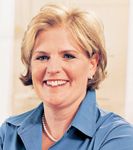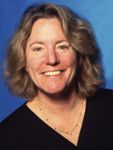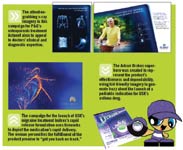Phase Six: Regain Confidence
Pharmaceutical Executive
In a bright airy office above fifth avenue in New York, Lynn O'Connor Vos is talking about topics dear to her heart: trust-and how pharma can regain it-the need to put physicians back in the center of pharmaceutical marketing, and reinvention, a theme in her own life and the core to her approach to business.
IN A BRIGHT, AIRY OFFICE ABOVE FIFTH AVENUE IN NEW YORK,Lynn O'Connor Vos is talking about topics dear to her heart: trust—and how pharma can regain it—the need to put physicians back in the center of pharmaceutical marketing, and reinvention, a theme in her own life and the core to her approach to business.
"Pharmaceutical marketing used to be a sacred industry—and a kind of secret," she says. "You'd go to a party and say 'I work in pharmaceutical marketing.' They'd look at you as if to say, 'What's that?' Nobody thought that there was marketing to doctors."
No more. At a time when trust in pharma is falling and the public increasingly sees marketing as just another word for manipulation, seemingly everyone is all too aware that there is marketing to doctors, and now to consumers—and all too eager to put an end to it.

But what can the industry—and its partners—do? "There's an interesting equation in The Trusted Advisor by David Maister, Charles Green, and Robert Galford," says Vos. "When self-promotion goes up, your opportunity for trust goes down."
And self-promotion has been a big part of pharma marketing, especially in recent years. "Think of detailing. There's a lot of self-promotion in it. It's all about the data and telling doctors the same thing over and over again. We'll never win the trust back that way."
The key, Vos says, is to focus on another variable in the trust equation: intimacy. "Intimacy means that you have to understand the doctor—where they live, what their issues are, how we can help them effect a better practice," Vos says. "Let's not just present them the data. Let's present them with some interesting consumer insights. We know about consumers—but we've never shared it. And let's actually help them be more effective physicians. Let's improve their credibility. We love this industry. We've got to get the trust back."
It's no surprise that Vos sees the solution (as well as the source) of many of pharma's problems in communications. She has worked in the field for more than 20 years, most recently as CEO of Grey Healthcare Group (GHG). Under Vos' leadership, GHG has grown into a global company with more than $1 billion in billings, 725 employees and 42 offices in 21 countries. She oversees an organization that comprises not only advertising, PR, and medical education, but also consulting, contract sales, direct marketing, and research units. In campaign after campaign, she has made innovative use of patient and physician education alongside traditional advertising and PR. Recent projects include AstraZeneca's Crestor (rosuvastatin); Exubera, Pfizer and Sanofi-Aventis' inhaled insulin product; ReFacto (recombinant antihemophilic factor), from Wyeth; and Actonel (risedronate), an osteoporosis drug from Procter & Gamble—among many others.
Vos and her agency have won numerous awards. But this year she is the recipient of an honor from an organization she's supported for years: the Healthcare Businesswomen's Association (HBA), which selected Vos as its Woman of the Year. In part, the award reflected the success of GHG. But in reading the nominating letters, it is clear that there were other, equally important factors: Vos' vision and innovative spirit, the breadth of her expertise, her commitment to her employees, and her well-known passion for pro bono work.
To mark the occasion of the award, Pharm Exec recently sat down with Vos to discuss her career, her philosophy of healthcare communications, and the importance of public service.

TimeLine
Every Place Is a New Opportunity
"My childhood was characterized by lots of moving," Vos says. "I was in about seven different schools before high school. It's not easy moving like that, and it's particularly challenging in September when you have to walk into the cafeteria and find somewhere to eat lunch and meet somebody. That gave me some internal confidence and the ability to recognize that every place is a new opportunity." She learned how to start anew—a lesson that would prove useful when, years later, she found herself in an industry that requires constant reinvention.
In her teens, Vos developed a taste for working. "It was tough to meet people in a school with four thousand students," she says, "but you always had a way to do that if you found jobs and volunteer work. I worked as a waitress and a short order cook. I was even an Avon lady at one point just to see what it was like."
That appetite for work meant that when Vos attended college, she was looking forward to graduating and getting a job. She loved medicine and took the prerequisites for medical school, and ended up earning a degree in nursing.
"The timing was perfect," she says. "Nursing was paying extremely well back in the Seventies. I landed one of the better jobs at Children's Hospital of Philadelphia, working with adolescents, my favorite age."
A Lot of Rope
But as the '80s began, wanderlust set in. Vos saw a newspaper ad that said Johnson & Johnson needed nurses who wanted to travel. She jumped at the opportunity and signed on as a clinical research associate.
She liked the travel and recognized the opportunity the pharma industry offered. But clinical research didn't suit her personality. "It's something that requires intense scrutiny and detail orientation, and I'm actually the opposite of that," says Vos with a laugh. She moved to Novo (before its 1989 merger with Nordisk), where the team researched emerging protocols—including insulin pumps—interacted with thought leaders and worked in leading diabetic centers. "I worked for a man who gave you a lot of rope and a lot of opportunity to dream," says Vos. Up against Eli Lilly, the Goliath of the insulin business, they were successful at engaging doctors and helping to improve diabetes management in the United States.

Greyôs Greatest Hits
The experience showed Vos how physician and patient education could be integrated to create awareness and enhance patient care. "It opened my eyes to the concept we later dubbed 'Phase Five market conditioning,'" she says.
Looking for a new challenge, Vos joined Pfizer—at just about the time the arthritis drug Feldene (piroxicam), Pfizer's first drug to cross the billion-dollar mark, and the antihypertensive Procardia (nifedipine) were launching. "What a fun opportunity," says Vos. "We developed unique programs educating doctors and patients with novel communications programs that really worked—big convention booths, a three hundred sixty-degree theater, walk-through holograms for Feldene.
"Pfizer was ahead of its time back then. We did a tremendous amount of work with medical associations, and developed the president's forum and the executive director's forum, where we recruited some smart thinkers like [Princeton's renowned healthcare economist] Uwe Reinhardt, to talk with pharma company presidents about the issues affecting the industry. It was an exciting, productive time."
Classic Market Conditioning
While at Pfizer, Vos met Alan Gross, who had recently launched a soon-to-be legendary advertising and PR agency with his wife—Jane Townsend—Ronnie Hoffman, and David Frank. Vos and Gross talked for a couple of years about her crossing over to the agency side, and in 1986 she moved to Gross' company: Gross Townsend Frank Hoffman (GTFH).
This was a turning point for Vos. The first statin, Merck's Mevacor (lovastatin), was about to launch, and Boehringer Mannheim (today a part of Roche) had developed a convenient, portable cholesterol screening device. GTFH went after and won both accounts.
Barbara Blasso, president of GHG's accredited continuing education unit, International Meetings & Science, says, "As a result of Lynn's thinking, leadership, and dedication to understanding the true impact this drug would have on people's lives, GTFH got the business—and she played a significant role in how cholesterol is perceived."

The GTHF team understood that the new combination of a screening device and a drug to treat cholesterol could revolutionize patient care—and the pharma industry. For Vos, it was one of the most significant experiences of her career. "We learned that you can really create a market and help doctors and patients. It's an exciting, complicated business that requires thorough medical education planning and associating yourself with the right issues," she says. "We connected early with the National Cholesterol Education Program [NCEP] and developed the first consensus conference with Merck and Boehringer Mannheim and the NCEP, which helped create new cholesterol education guidelines."
The Mevacor experience had two immediate effects. One was that GTFH was so successful that Grey Global Group acquired the agency in 1987. And GTFH expanded its range of services with the launch of its own med ed company—Phase Five. In charge: 28-year-old Vos.
"I launched Phase Five with a phone and a desk," says Vos. "It was probably the first model for raising consumer awareness, educating doctors about the new goals, training them how to treat, and then bringing those two together to drive change."
"What Lynn did at Phase Five is now classic market conditioning. Back then it was pioneering," says Ilyssa Levins, who headed GTFH's PR business at the time. (It later became Grey's wholly owned partner GCI. Levins continues as executive vice president of GCI, a wholly owned partner of GHG, and managing partner of the GCI/GHG joint venture BrandEdge.)

"I'd Like to Run It"
In 1991, GTFH suffered a round of devastating losses. Partner Ronnie Hoffman suddenly died of a cerebral aneurysm. "Ronnie was the creative genius of GTFH," says Vos. "She was also one of the most brash, direct, exciting women you'd ever want to meet, and a brilliant copywriter and someone who was my personal coach and cheerleader. It rattled all of us."
Alan Gross and Jane Townsend retired and moved to the island of Bonaire. That was potentially fatal news for the firm they had founded. "It's highly unlikely that a communications company can survive when all the partners leave," says Vos. But Gross, Townsend, and Hoffman were people who inspired loyalty, and a group of executives kept the company alive.
Eventually Vos went to Grey with a proposal. "I said, 'Look, I'd like to run it.' So I jumped into being the CEO of GTFH. We renamed it Grey Healthcare Group. It was an opportunity to reinvent a company."
The renamed company had strong leadership. Wendy Balter (currently president of Phase Five) and Blasso, Vos' partners, took over Phase Five. Cindy Machles, currently president of BrandEdge, represented advertising, and Levins ran the PR business. In 1998, Vos recruited Jane Parker, who had extensive experience on the consumer side, to be group president, worldwide advertising.
"The advertising business requires intensive management, reinvention and attention to what going on out there," says Vos. "When Jane joined, we were concerned with strengthening the agency, establishing the esprit de corps for the advertising business, and working toward excelling at creative and client service. Jane is brash, frank, open, and honest—the characteristics I love in people. She helped us move that agency piece forward."

GHG structured itself for growth. It pioneered the "single P&L"—individual companies within GHG benefit when the company as a whole does well. In traditional communications holding companies, individual units compete with each other, and it can be difficult to coordinate cross disciplinary programs. The single P&L is designed to combat that. As globalization emerged as an urgent issue, GHG convinced its parent company that it was important to put US and European (and more recently, Asian) efforts under the same leadership.
The company has tripled in size since 1991, and an unusually large portion of the increase has come in the form of organic growth rather than acquisitions. In the past two years alone, GHG has acquired or launched more than a dozen new companies, including:
- Summit Grey, which offers on- and off-line med ed programs and interactive solutions
- Insight Medical Communications, and CME Scholar, full-service med ed divisions
- s&kGrey, one of Germany's top oncology med ed companies
- DarwinGrey, a UK-based oncology communications company
- Hurd Studios, a scientific multimedia firm with animation, video production, and marketing capabilities
- BrandEdge, a consulting and portfolio management company
- Avenue Grey, a DTP/DTC customer relationship marketing agency supported by behavioral scientists and in-depth consumer research
- Nova Grey, with consumer expertise and close ties with Grey Worldwide
- GHG Japan and Sorento Grey Healthcare India, which added advertising and med ed expertise to Asia
A Warning Isn't Enough
It's perhaps a tribute to Vos and GHG that when FDA's self-proclaimed watchdog, David Graham released his list of drugs he wanted to see off the market, four of the five—all but Roche's Accutane (isotretinoin)—were GHG clients. Products like these, which arouse controversy and generate large volumes of contradictory information, are particularly sensitive to market—and they cut to the heart of the issue of trust.
There are two parts to rebuilding trust, as Vos sees it. First, the physician has to be brought back into the equation. "When we were first doing consumer advertising," Vos says, "we would agonize over one thing: How are we going to explain what's going on to doctors? We need to tell them that patients will see this, and here's what the storyboard looks like, and what to do if you have questions. That's eroded over the years."

But today, when patients show up at the physicians' offices armed with Internet pages on their conditions, and sometimes strong opinions on how they should be treated, a simple warning isn't enough. There is a real need for material that helps physicians do their jobs. "We need to arm them with better understanding of the consumer, of what's going on in patients' minds so they can practice better medicine," says Vos.
A tall order, but in fact, there are precedents, she says. "In the early days at Pfizer we created something called Interactive Medicine to help doctors communicate with patients. Today at Grey, we're inventing something called 'The Doctor Will Hear You Now,' an attempt to get the doctor and patient on the same page, so doctors will better understand the insights of consumers. We're doing this now in the hormone replacement therapy [HRT] category."
The other essential, says Vos, is full disclosure, which, in her experience, can work wonders for even highly threatened products—if handled with the right kind of craftsmanship.
"In the nineteen-eighties, we represented Tonocard [tonocainide] and the product got a black box," she says. "When you got a black box back then, it was big stuff. The drug was in the antiarrhythmic category, where there were few competitors. Ronnie Hoffman, who came out of direct marketing, sent a beautifully crafted letter informing physicians about the warning—and prescriptions doubled over time." Why? Doctors like full disclosure, Vos says. It gives them a greater comfort level. When they know the whole story, they can prescribe more effectively.
More recently, Vos has been involved in untangling the issues surrounding HRT, which has been under continuous assault for the past four years or so. To fight back, the Grey team helped Wyeth, maker of Premarin, to launch a campaign centered on disclosure. "It's a story that hasn't been told broadly enough, what a great job Wyeth has done with that brand," says Vos. "They repositioned with honest, full disclosure. They say the product is now for short-term use; to take as little as possible for as little time as possible. And doctors didn't want to get that conservative. They really were much more pro-HRT than anyone out there. Now you're seeing the category return."
"Volunteer Work Is the Rent We Pay"
Talk to people who work with Vos, and inevitably they'll bring up her commitment to volunteer and pro bono work, which she has made part of the company culture. GHG offers pro bono services to numerous clients, including the Helen Keller Foundation (a relationship that's continued for 15 years), the Multiple Myeloma Research Foundation (MMRF), and the Jed Foundation, which works to reduce the suicide rate among college students and young adults. Vos personally serves on the boards of organizations including MMRF, Jed's Foundation, and the YWCA of the City of New York. She encourages her employees to do the same.

In part, this is just a continuation of a long-standing habit. "I recently heard someone say, 'Volunteer work is the rent we pay for being on the planet.' I believe in that."
But there is also a strong element of personal friendship in several of Vos' relationships with charitable organizations. For example, Kathy Giusti, founder and president of MMRF, was a client of Vos'. They met in the early '90s and worked together on an innovative program for Searle's NSAID Daypro (oxaprozin) that used arthritis patients to train physicians. In 1998, Giusti was diagnosed with multiple myeloma.
"She went around the country and found that there was no cure, then she called a few of us and asked us to help her set up a foundation," says Vos. "I didn't know what that meant back then. But Kathy is a powerhouse, so we joined the board and got started."
"Lynn keeps me on my toes," says Giusti. "At board meetings she asks the right questions and asks them for the right reason. When you're a charity, you want to be in the right, and she puts you in that position."

"What's exciting about MMRF is that we invented something from nothing," says Vos. "That's what turns me on. That's the industry. The agency business? We're selling ideas. You start with nothing and create something. That's extremely exhilarating. Same with MMRF."
Another of Vos' significant commitments is to the Jed Foundation, founded in 2000 by Phillip Satow, another friend and client (they worked together on the launch of Celexa [citalopram].) Satow, an executive vice president and board member at Forest, was just days away from his scheduled retirement when his son Jed, a sophomore at the University of Arizona, committed suicide. "I had lunch with Phil about a month later," says Vos. "I said, 'What can we do? We've got to do something.'
"Teenage suicide is a huge problem. It's not so much that the number of suicides is increasing but that the attempts are going up, particularly among girls in college. With the help of many people at Grey Healthcare, we set up something called Ulifeline, an Internet program in more than six hundred and fifty colleges and universities that supports students and enables them to take a quiz to see if they or their roommate's at risk."
Currently the foundation is working with five Ivy League schools to develop recommendations for the kind of environment that reduces student suicide.
"It's nice to give to organizations like these," says Vos, "but I also get a lot back. These are interesting, wonderful people to work with, and challenging intellectually."
The commitment to pro bono work is closely tied to Vos' concern with balance. Like many other executives, she believes in making time for both work and family. But she thinks another dimension is often left out.

"I encourage everybody who works here to recognize that there's a third important part of your life, and that's you. It's important that you work on yourself. That could mean exercising every day. It also could mean joining a board or an organization or board outside our industry to expand your mind, meet different people, hear different opinions and bring those back, to enrich your life and your career.
"I feel it's one of the reasons we're on the planet—to make your life interesting and make other people's lives interesting. If you're not out there, you're not doing it. Everyone here knows that that's my view. Many of them have jumped into getting engaged in boards and love it. And it's important for us to carve time out for that. It's great for the people and the company."
It's also great for the future. Vos cites a study done by Simmons College a few years back that asked kids if they would go into business. Most of the girls said no.

"One has to look in the mirror and ask why," Vos says. "What do we look like? Being in business will only be attractive to our children if we look like happy, well-rounded, enthusiastic people, and that's only going to happen if continue to reinvent ourselves."

The Misinformation Maze: Navigating Public Health in the Digital Age
March 11th 2025Jennifer Butler, chief commercial officer of Pleio, discusses misinformation's threat to public health, where patients are turning for trustworthy health information, the industry's pivot to peer-to-patient strategies to educate patients, and more.
Navigating Distrust: Pharma in the Age of Social Media
February 18th 2025Ian Baer, Founder and CEO of Sooth, discusses how the growing distrust in social media will impact industry marketing strategies and the relationships between pharmaceutical companies and the patients they aim to serve. He also explains dark social, how to combat misinformation, closing the trust gap, and more.